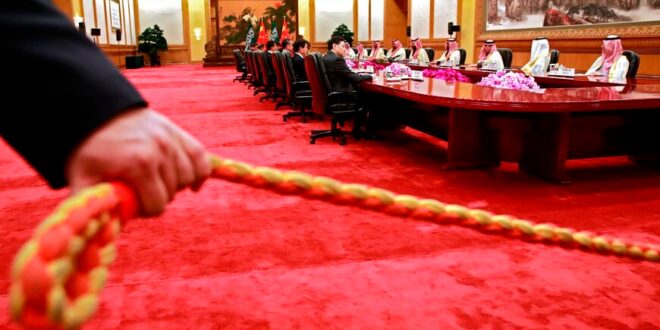Hemingway’s law of motion says change comes gradually, then suddenly.
The other China deal
Much attention has been rightly focused on China’s role in closing the deal between Saudi Arabia and Iran to reestablish diplomatic relations.
Another deal has gotten less attention, but may be just as telling in serving notice of China’s intentions in the region and beyond.
Last month China National Offshore Oil Corporation (CNOOC) and France’s TotalEnergies conducted the first ever yuan-settled energy deal involving 65,000 tons of Emirati liquified natural gas, as Salim Essaid reports. Iraq and Saudi Arabia have also said they too are ready to deal in yuan, as Adam Lucente reports. Additionally, China and Brazil reached an accord this week to conduct their trade in yuan.
US diplomats in the region are increasingly focused China’s machinations, especially sensitive technology transfers, and quietly letting it be known that the United States does not want to see trade in yuan become a trend.
So far the CNOOC-Total deal is a standalone, and US officials hope to keep it that way. Saudi Arabia and Iraq, for example, have not yet agreed to yuan-denominated transactions. So far it’s just talk. But the potential trend lines may signal a long-term Beijing strategy to undercut US influence in the Middle East and other regions.
Divided on the threat to exorbitant privilege
Officials and experts are divided on whether increased yuan-denominated trade in the Middle East and worldwide could represent a threat to the dollar’s role as a reserve currency in the global economy.
New York Times columnist Paul Krugman, among others, argues that the yuan is no threat to the dollar. Subject to capital controls, the yuan can’t match the global liquidity of the dollar without a radical change in Chinese monetary policy.
Close to all major financial transactions, including in energy markets, are denominated in dollars. The dollar accounted for 96% of world trade in recent decades, while the yuan came in at 2% in 2022.
Krugman adds that even if the dollar’s position were threatened, “it wouldn’t be a big deal.”
Others aren’t so sure. “China may have capital controls,” writes Nouriel Roubini in the Financial Times, “but the US has its own version that may reduce the appeal of dollar assets among foes and relative friends. These include financial sanctions against its rivals, restrictions to inward investment in many national security-sensitive sectors and firms and even secondary sanctions against friends who violate the primary ones.”
Roubini sees an emerging “bipolar currency regime” that will sooner or later eat away at the dollar’s privileged status, especially since the United States runs permanent current account deficits, raising questions about the sustainability of America’s international liabilities.
Dollar’s digital future at stake?
The dollar may also be the focus of a Chinese digital ground game focused in the Middle East and other regions.
While cryptocurrencies got creamed over the past year, with Bitcoin losing 60% of its value and the collapse of FTX, China is continuing to seize the initiative in Web3 blockchain technologies and token-based economics, especially in Asia and the Middle East.
The Middle East, despite the FTX fiasco and related blowback and scandals, remains a hub and even incubator for fintech. “Although still in its infancy, growth in the Islamic fintech market, which is currently estimated at $79 billion, is expected to increase by 18% annually, with the top six countries in it being Saudi Arabia, Iran, Malaysia, the UAE, Turkey and Indonesia, which together accounted for 81% of the total market size,” reports Salim Essaid.
And the United States may not be keeping pace relative to Chinese initiatives to claim its currency’s share of the digital economy.
Brandon Possin, a foreign service officer serving at the US Embassy in Tokyo and an investor in digital assets, writes,“The dollar’s influence on the digital future is at stake.”
For example, China seeks some digital payments via mBridge Ledger, a blockchain system that uses the digital currency of China’s central bank.
“Digital assets pegged to the dollar, called stablecoins, project the dollar into the digital economy,” writes Possin. “But if, say, an Indonesian natural resource exporter can only get paid on China’s own closed network and cannot be paid in US-dollar-denominated digital assets such as dollar-backed stablecoins, the US financial system will suffer.”
The geopolitical context
The debate over whether the dollar faces a challenge from the yuan requires geopolitical context, including the impact of US sanctions and restrictions on investments in sensitive technology sectors, as Roubini points out.
Consider the emerging geopolitical and trading alignment among China, Russia and Iran, all of which have an interest in working around US sanctions and the dollar. That’s 1.7 billion people in those three countries. Then factor in the various states in the Middle East, Africa and Asia — India, Pakistan, Saudi Arabia, Iraq, Syria, South Africa, etc — who may be receptive to deals in alternative currencies to facilitate trade with China or to work around US sanctions, or both.
That’s a formidable market for Chinese currency and a lot of territory for the United States to play defense.
This is all playing out all in the context of an increasingly assertive Chinese foreign policy and the rise of leaders, in the region and around the world, who are charting their own course while seeking to keep good relations with both Washington and Beijing.
‘Gradually, and then suddenly’
“How did you go bankrupt?” asks Bill in Ernest Hemingway’s 1926 novel “The Sun Also Rises.”
“Two ways,” answers Mike. “Gradually, and then suddenly.”
Hemingway’s law of motion, as it has come to be known, may or may not apply with regard to the dollar’s privileged position. There are structural reasons the yuan today is no match for the greenback. That said, history is flush with reassuring forecasts prior to economic calamity. If there is such a threat, we are at the beginning of the beginning. But that’s the point. It’s easier to manage a potential crisis in the “gradually” stage, rather than the “suddenly” one.
 Eurasia Press & News
Eurasia Press & News



